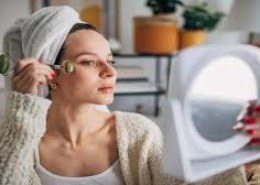Acne is a common skin condition that affects millions of people worldwide, often leading to frustration and a search for effective treatments. Among various remedies, essential oils and face rollers have gained popularity for their potential to improve acne-prone skin. This guide explores how to incorporate these tools into your skincare routine to achieve clearer, healthier skin.
Understanding Acne and Its Causes
Before diving into treatments, it’s important to understand what causes acne. Acne occurs when hair follicles become clogged with oil and dead skin cells. This blockage can lead to whiteheads, blackheads, and pimples. Factors contributing to acne include:
- Hormonal changes: Especially during puberty, menstruation, pregnancy, or stress.
- Genetics: A family history of acne can increase the likelihood of developing it.
- Diet: Foods high in refined sugars and dairy may exacerbate acne.
- Skincare products: Using products that are not non-comedogenic can clog pores.
- Bacteria: Propionibacterium acnes (P. acnes) bacteria can cause inflammation and pimples.
Essential Oils for Acne-Prone Skin
Essential oils are concentrated plant extracts known for their aromatic properties and therapeutic benefits. When used correctly, they can be a powerful addition to your acne treatment regimen. Here are some of the most effective essential oils for acne-prone skin:
1. Tea Tree Oil
Tea tree oil is one of the most popular essential oils for acne due to its antibacterial and anti-inflammatory properties. It can help reduce the bacteria that cause acne and soothe inflamed skin.
How to Use:
- Dilute tea tree oil with a carrier oil (like jojoba or coconut oil) at a ratio of 1:9.
- Apply the mixture directly to the affected areas using a cotton swab.
- Use it once or twice daily as part of your skincare routine.
2. Lavender Oil
Lavender oil is known for its calming and anti-inflammatory effects. It can help reduce redness and swelling associated with acne and promote healing.
How to Use:
- Mix a few drops of lavender oil with a carrier oil.
- Apply it to the affected areas before bedtime.
- It can also be added to your nightly moisturizer for an overall calming effect.
3. Rosemary Oil
Rosemary oil has antimicrobial properties that can help prevent the growth of acne-causing bacteria. It also improves circulation, which can aid in healing and skin rejuvenation.
How to Use:
- Combine rosemary oil with a carrier oil.
- Gently massage the mixture onto your face, focusing on acne-prone areas.
- Use it once daily, preferably in the evening.
4. Clary Sage Oil
Clary sage oil can help regulate oil production and reduce inflammation, making it a good option for those with oily, acne-prone skin.
How to Use:
- Dilute clary sage oil with a carrier oil.
- Apply to your skin after cleansing.
- Use it once a day to help balance your skin’s oil production.
Benefits of Face Rollers for Acne-Prone Skin
Face rollers, typically made from jade or rose quartz, are tools used to massage the face. They have gained popularity for their potential to improve skin health and appearance. Here are the key benefits of using face rollers for acne-prone skin:
1. Improved Blood Circulation
Face rollers can enhance blood flow to the skin, which helps nourish skin cells and keeps them healthy. Improved circulation can also promote faster healing of acne lesions.
2. Reduced Inflammation and Puffiness
Using a face roller can help reduce inflammation and swelling. The cooling effect of jade or rose quartz can soothe irritated skin and reduce the appearance of redness.
3. Enhanced Product Absorption
Massaging your skin with a face roller can help improve the absorption of skincare products, allowing the active ingredients in your treatments to penetrate deeper into the skin.
4. Lymphatic Drainage
Face rolling can stimulate the lymphatic system, helping to remove toxins and reduce fluid buildup. This can lead to a clearer, more radiant complexion.
How to Use a Face Roller with Essential Oils
Combining essential oils with a face roller can enhance the benefits of both. Here’s a step-by-step guide to incorporating these tools into your skincare routine:
Step 1: Cleanse Your Face
Start with a clean face to ensure that you’re not massaging dirt and bacteria into your skin. Use a gentle cleanser suitable for acne-prone skin.
Step 2: Apply Essential Oils
After cleansing, apply your diluted essential oil mixture to your face. Focus on acne-prone areas, but also apply a light layer to the rest of your face for overall benefits.
Step 3: Use the Face Roller
- Forehead: Start at the center of your forehead and roll outwards towards your temples.
- Cheeks: Roll from the nose outwards to the ears.
- Jawline and Chin: Roll from the center of your chin outwards along the jawline.
- Neck: Roll downwards from your jawline to your collarbone.
- Use gentle pressure and ensure the roller is cool (you can refrigerate it for added benefits). Roll each area for about 30 seconds to a minute.
Step 4: Follow with Moisturizer
After using the face roller, apply a lightweight, non-comedogenic moisturizer to lock in the benefits of the essential oils.
Tips for Success
- Patch Test: Always do a patch test before using any essential oil on your face to ensure you don’t have an allergic reaction.
- Consistency: For best results, incorporate essential oils and face rolling into your daily skincare routine.
- Cleanliness: Clean your face roller regularly with gentle soap and water to prevent bacterial buildup.
- Hydration: Drink plenty of water to keep your skin hydrated from within.
Conclusion
Using essential oils and face rollers can be an effective, natural way to manage acne-prone skin. By understanding how to use these tools correctly and consistently, you can enhance your skincare routine and work towards achieving a clearer, healthier complexion. Remember to be patient, as natural remedies can take time to show results, and always consult with a dermatologist if you have severe or persistent acne

